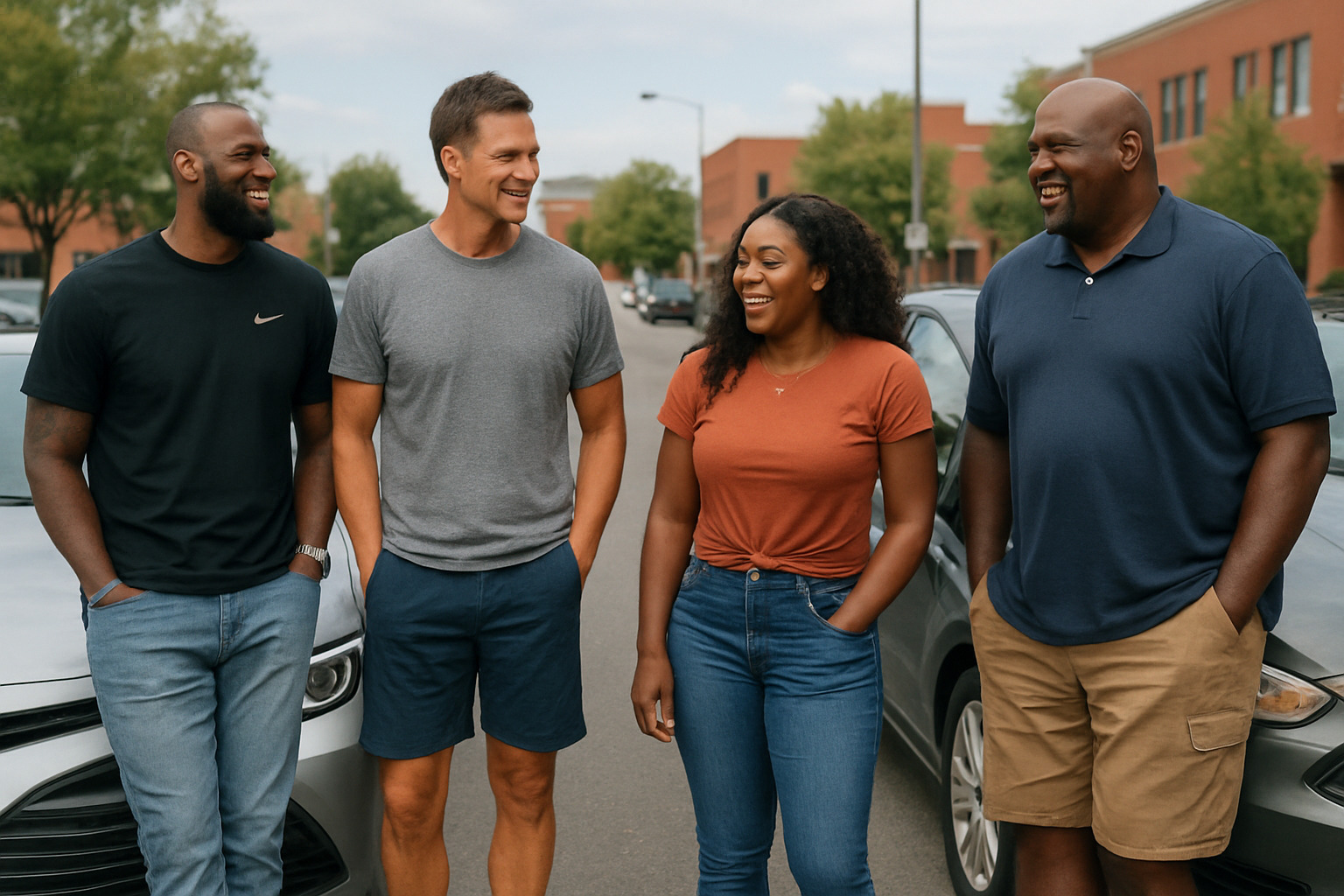athletes who endorse cheap cars: 7 Powerful Inspiring Stories 2025
When Superstar Athletes Choose Practicality Over Prestige
When luxury sports cars seem like mandatory accessories for the rich and famous, something refreshing is happening in 2025. Many of our favorite sports heroes are breaking the mold by choosing—and proudly endorsing—surprisingly affordable vehicles.
The sight of a basketball legend stepping out of a family sedan rather than a Ferrari creates a powerful contrast that resonates with fans. These athletes who endorse cheap cars aren’t just making marketing decisions—they’re often making lifestyle choices that reflect personal values and smart financial thinking.
Take LeBron James, basketball royalty worth over $350 million in 2025, who became the face of Kia’s K900 sedan. While the $60,000 price tag isn’t pocket change for most of us, it’s a fraction of what someone with LeBron’s wealth might typically drive. When criticized about whether he actually drove the car, LeBron responded with social media videos showing himself commuting in his K900, insisting, “I was a Kia K900 driver and fan before we decided to become partners.”
Then there’s NFL quarterback Kirk Cousins, who despite earning nearly $40 million in the 2025 season, drives a dented GMC Savana van purchased from his grandmother for $5,000. His philosophy? “It’s better to buy appreciating assets than depreciating. No yachts, no sports cars.” That’s financial wisdom rarely heard in professional sports circles.
Perhaps most charming is Alfred Morris’s story. The NFL running back famously drove a 1991 Mazda 626 nicknamed “Bentley” that he purchased for just $2. Despite signing a multi-million dollar contract, Morris kept his beloved Mazda, explaining it helped him stay humble and remember his roots.

Other notable examples include Steph Curry with his Infiniti Q50, valued around $20,000 used—a modest choice for someone worth over $300 million in 2025. Bills wide receiver Khalil Shakir drives a practical Subaru, while MLB star Brandon Nimmo sticks with his 2010 Nissan Altima despite earning millions.
These choices resonate powerfully with fans because they feel authentic. When athletes choose everyday brands that align with ordinary people’s lives, it creates a genuine connection that flashy luxury endorsements often miss. Consumers in 2025 are increasingly savvy about detecting when a celebrity truly believes in a product versus when they’re just collecting a paycheck.
The trend also reflects a broader shift in how we view success and status. These athletes demonstrate that true confidence doesn’t require external validation through expensive possessions. By choosing practicality over prestige, they’re showing fans that financial wisdom and staying grounded are values worth celebrating—perhaps even more than the temporary thrill of a sports car.
For brands like Kia, Infiniti, and Subaru, these partnerships offer something priceless: credibility with consumers who might otherwise dismiss their vehicles as not prestigious enough. And for the athletes themselves, these endorsements often feel more aligned with their personal values than promoting ultra-luxury brands ever could.
Why Athletes Who Endorse Cheap Cars Buck the Luxury Trend
When most of us picture a pro athlete’s garage in 2025, we imagine rows of gleaming Lamborghinis and custom Bentleys. But a refreshing counter-trend is emerging as more sports stars choose to drive—and endorse—surprisingly affordable vehicles. The story behind athletes who endorse cheap cars reveals something meaningful about values, smart money decisions, and changing definitions of success.
For many athletes, the choice is deeply personal. Growing up with modest means shapes spending habits that stick, even after signing multi-million dollar contracts. The humble vehicle becomes a grounding force—a daily reminder of the journey and struggles that brought them to success.
“I was never a big spender. We didn’t have much growing up, so I guess I got used to it,” former NFL cornerback Nnamdi Asomugha shared in a recent 2025 interview. “Even when I was a Pro Bowl player in the NFL, I lived the same way because that’s what I knew.”
These partnerships create a win-win situation that feels genuine. Fans can spot an inauthentic endorsement from a mile away. When an athlete truly appreciates the practical benefits of a vehicle—rather than just collecting a hefty endorsement check—it resonates with everyday consumers.

The economics behind athletes who endorse cheap cars
Let’s talk dollars and sense. The financial wisdom behind choosing affordable vehicles becomes crystal clear when you look at the math. That shiny new luxury car? In 2025, it loses roughly 20% of its value the second you drive it off the lot, and up to 60% within five years. For athletes thinking long-term, avoiding this financial nosedive is just smart planning.
Kirk Cousins perfectly captures this mindset. Despite earning a jaw-dropping $40 million in the 2025 season, he continued driving a dented GMC Savana van purchased from his grandmother for just $5,000. As he told financial analysts: “It’s better to buy appreciating assets than depreciating. No yachts, no sports cars.”
This approach isn’t about being cheap—it’s about being strategic. By choosing modest transportation, athletes can redirect substantial earnings toward investments that actually grow over time: real estate, business ventures, and stock portfolios. The difference in wealth accumulation over a career can be staggering.
Public reaction to athletes who endorse cheap cars
When fans find their sports heroes driving everyday cars, the response is overwhelmingly positive. In today’s world of widening economic gaps, seeing wealthy individuals make practical, relatable choices feels refreshingly authentic.
Social media lights up with praise when these stories emerge. When NFL running back Alfred Morris’s beloved 1991 Mazda 626 (affectionately nicknamed “Bentley”) became public knowledge, fans accepted him as more genuine and down-to-earth than many of his flashier peers.
These endorsements also work wonders for brand credibility. When consumers see a multimillionaire athlete genuinely choosing an affordable vehicle, it validates the quality and appeal of these accessible brands. The underlying message becomes powerful: “If this car is good enough for someone who could afford anything, it must be pretty special.”
The authenticity factor can’t be manufactured—it has to be real. And that’s exactly why athletes who endorse cheap cars create such meaningful connections with fans and consumers alike in 2025.
LeBron James – Proud Ambassador of the Kia K900
When basketball legend LeBron James announced his role as Kia’s first-ever luxury ambassador, eyebrows raised across the sports world. As of 2025, with his net worth estimated at over $350 million, many still wonder how someone of his stature could genuinely choose a $60,000 Kia sedan when he could park any exotic supercar in his garage.
But LeBron was quick to set the record straight: “I was a Kia K900 driver and fan before we decided to become partners, so I’m really excited to be Kia’s first-ever luxury ambassador,” he explained when the partnership launched.
The K900, while positioned as Kia’s flagship luxury model, represents a significant departure from the Lamborghinis and Ferraris typically associated with NBA superstars. With its $60,000 starting price in 2025, the K900 costs substantially less than luxury competitors like the Mercedes-Benz S-Class or BMW 7 Series, which command six-figure price tags.

What’s particularly interesting is that AMCI Testing – an independent automotive research firm – certified the K900 as quieter, smoother, and better riding overall than luxury stalwarts like the Audi A8 4.0T, BMW 750i, and Lexus LS460. This objective validation added genuine credibility to LeBron’s endorsement.
The partnership challenged conventional wisdom about luxury, status, and value. As LeBron put it: “This partnership is about the power of great style and performance. Kia and the K900 are out to challenge conventional wisdom and show people how to think differently, and I can relate to that.” You can learn more about this groundbreaking partnership at Kia’s official announcement.
Do athletes who endorse cheap cars actually drive them?
It’s the million-dollar question fans always ask about athletes who endorse cheap cars: Do they actually drive what they’re selling, or are they collecting endorsement checks while cruising in something more exotic?
In LeBron’s case, his teammate Richard Jefferson settled the debate with a candid social media video showing James climbing into his K900 after practice. Jefferson playfully captioned it: “There’s a 1,000 percent chance that there’s a 100 percent chance that LeBron drives a Kia.”
This kind of authenticity resonates deeply with consumers in 2025. When we see athletes genuinely using the products they promote, the message transforms from “buy this because I’m famous” to “I choose this because it truly delivers value.” The connection feels real rather than transactional.
Not all athlete endorsements maintain this level of authenticity, though. Some sports stars have faced embarrassing moments when caught using competitors’ products. Blake Griffin, for instance, starred in Kia Optima commercials while paparazzi snapped him driving a $140,000 Mercedes-Benz S63 AMG in his personal life.
The most powerful partnerships – like LeBron and Kia – align the athlete’s actual lifestyle choices with the brand they represent. This creates genuine advocacy that consumers can trust and relate to, regardless of their own budget. For more insights into how these endorsement relationships work, check out Car News 4 You’s athlete car endorsement coverage.
Steph Curry – Daily Driving a Depreciated Infiniti Q50
With a net worth soaring past $300 million in 2025 and a jaw-dropping $215 million Under Armour endorsement deal, Stephen Curry could easily cruise around in a different supercar every day of the week. And while his garage does house some impressive rides like a sleek Porsche Panamera and a customized Ford GT, his everyday choice raises eyebrows for an entirely different reason – a modest, depreciated Infiniti Q50.
Curry’s relationship with Infiniti began when he became their brand ambassador, receiving a shiny Q50 as part of the deal. What’s genuinely refreshing is that years later, he still regularly slides behind the wheel of this practical sedan. In 2025, you could pick up the same model on the used market for under $20,000 – pocket change for someone of Curry’s financial stature.

There’s an interesting backstory that might explain his attachment to the more modest ride. Curry was involved in a highway accident in his Porsche 911 GT3 RS. Though he walked away unharmed, the experience may have sparked a preference for keeping his daily commute more low-key.
Plus, there’s the practical side to consider. The Q50 lets Curry blend in during his Bay Area travels, avoiding the swarm of attention that inevitably comes with driving something flashier. As one automotive journalist aptly put it in a 2025 review: “The Ford GT is clearly not a great choice if you’re trying to keep a low profile and stay away from the paparazzi.”
How an endorsement shapes car choice for athletes who endorse cheap cars
For athletes who endorse cheap cars in 2025, these partnerships go well beyond smiling for a few commercial shots. Many endorsement contracts come with specific requirements about actually using the vehicles they’re promoting.
Typically, these deals include access to a brand-provided fleet – often multiple vehicles for different needs and occasions. The fine print usually contains minimum usage requirements, like driving the endorsed car to games, practices, or public appearances where cameras might be clicking.
Social media obligations have become standard in these agreements too. Athletes might need to share a certain number of posts featuring their endorsed vehicle, giving brands organic exposure to millions of followers without the obvious commercial feel of traditional advertising.
Far from feeling restrictive, these arrangements often fit naturally into an athlete’s lifestyle. A comfortable, reliable sedan like Curry’s Q50 handles daily driving duties perfectly well, even for someone who could afford literally any car on the planet. The endorsement creates a win-win where the athlete gets hassle-free transportation while the brand receives authentic promotion from a trusted face.
When fans see stars like Curry genuinely using more accessible vehicles, it breaks down the perception that success requires extravagance. For more insights about athlete car endorsements and what drives these surprising partnerships, check out more info about athlete endorsement.
NFL Frugality Icons: Kirk Cousins & Alfred Morris
In a league where flashy sports cars and luxury SUVs dominate player parking lots, two NFL stars have become unlikely heroes of financial wisdom thanks to their remarkably humble vehicle choices.
Kirk Cousins, despite signing an eye-popping contract worth over $40 million annually with the Minnesota Vikings in 2025, continued his daily commute in a dented GMC Savana passenger van. This wasn’t just any van – it was a family hand-me-down purchased from his grandmother for a mere $5,000, complete with over 100,000 miles on the odometer.
“It’s better to buy appreciating assets than depreciating. No yachts, no sports cars,” Cousins explained in a 2025 interview, revealing a financial mindset that sets him apart from many of his peers. While teammates pulled up in vehicles worth six figures, Cousins remained perfectly content with his practical family hauler.

Then there’s Alfred Morris, whose story might be even more charming. The former NFL running back signed a multi-million dollar contract with a substantial signing bonus – yet continued driving the same 1991 Mazda 626 sedan he purchased during college for the princely sum of $2. Yes, two dollars.
Morris affectionately nicknamed his weathered Mazda “Bentley,” a playful nod to the luxury vehicles he could easily afford but chose to forgo. When asked why he kept the decades-old economy car, Morris’s answer revealed much about his character:
“It just keeps me grounded, where I came from and all the hard work for me to get to this point,” he explained. That simple sedan served as a daily reminder of his journey and the values that fueled his success.
Comparing contract size vs. car cost
The numbers tell a remarkable story about these athletes who endorse cheap cars and their financial priorities in 2025:
| Athlete | Contract Value | Vehicle | Vehicle Cost | % of Annual Salary |
|---|---|---|---|---|
| Kirk Cousins | $120+ million | GMC Savana Van | $5,000 | 0.01% of annual salary |
| Alfred Morris | Multi-million | 1991 Mazda 626 | $2 | <0.0001% of annual salary |
| LeBron James | $700M+ career earnings | Kia K900 | $60,000 | 0.3% of annual salary |
| Steph Curry | $300M+ net worth | Infiniti Q50 | ~$20,000 (used) | 0.05% of annual salary |
For context, the average American in 2025 spends between 10-15% of their annual income on transportation. These athletes are spending mere fractions of a percent – a testament to their financial discipline that goes against the stereotype of professional athletes burning through their earnings.
Beyond saving money upfront, these practical choices help these players avoid one of the biggest wealth drains affecting professional athletes: rapid vehicle depreciation. While a typical luxury vehicle might lose 50-60% of its value within five years, these modest vehicles hold their proportional value better while costing significantly less to insure and maintain.
These choices have made Cousins and Morris legends in their locker rooms and fan favorites. Their teammates, many driving vehicles worth more than some people’s homes, genuinely respect their commitment to financial discipline and staying true to their roots – proving that sometimes the most impressive statement you can make is choosing not to make one at all.
Under-the-Radar Stars Keeping It Simple
Beyond the headline-grabbing stories of superstar athletes like LeBron James and Steph Curry, many other professional athletes choose modest vehicles that reflect their practical values and personal histories in 2025.
Buffalo Bills wide receiver Khalil Shakir made waves when, after signing a hefty contract extension with substantial guaranteed money, he casually mentioned he had no plans to upgrade from his 2021 Subaru. When teammate Curtis Samuel joked, “Congrats man, now you can get yourself another car,” Shakir’s response was refreshingly straightforward: “I don’t really splurge much. That’s not really what I like to do.”
MLB player Brandon Nimmo has earned over $20 million during his baseball career as of 2025, yet still drives around in a 2010 Nissan Altima that’s seen better days – complete with a cracked dashboard and no Bluetooth. The car carries special meaning for Nimmo because his father purchased it using part of his college scholarship money. Despite being worth just a few thousand dollars and having around 100,000 miles on the odometer, the Altima’s sentimental value far outweighs its modest market price.
“When I throw luggage in the back, do I want to be doing that on a $100,000 Mercedes?” Nimmo explained with practical wisdom in a 2025 interview. “It keeps me humble.”

Former NFL offensive lineman John Urschel, who earned $1.8 million during his three NFL seasons before hanging up his cleats to pursue a Ph.D. in mathematics at MIT, became known for his frugal lifestyle. Urschel drove a used Nissan Versa hatchback and lived on less than $25,000 annually despite his NFL paycheck. In 2025, he continues to advocate for financial responsibility among athletes, sharing his experience: “I drove a used hatchback Nissan Versa and lived on less than $25,000 a year,” Urschel shared in a recent interview, highlighting how his practical approach to finances aligned with his thoughtful, analytical mindset.
Nnamdi Asomugha, who once commanded an impressive $11 million yearly salary as an NFL cornerback, continued driving the 1997 Nissan Maxima his brother gave him to drive to prom. “That car is the one thing that everyone makes fun of me for,” he admitted with a smile in a 2025 retrospective, but the combination of sentimental value and everyday practicality meant more to him than any flashy status symbol ever could.
What these stories teach us about athletes who endorse cheap cars
These stories of athletes who endorse cheap cars offer valuable lessons about fame, wealth, and staying true to one’s values in 2025. First, they show us that genuine financial security doesn’t come from flaunting wealth through expensive purchases, but from making sound financial decisions that preserve and grow wealth over time.
These athletes serve as powerful role models, especially for young fans who might otherwise assume that success requires flashy spending. By choosing practical vehicles, they demonstrate that wealth doesn’t have to change your fundamental values or disconnect you from your roots.
The financial literacy displayed by these athletes stands out in stark contrast to concerning statistics from 2025 – approximately 78% of NFL players face financial distress within just two years of retirement, while around 60% of NBA players experience similar struggles within five years of leaving the game. By avoiding the rapid depreciation that comes with luxury vehicles, these practical-minded athletes position themselves for long-term financial stability.
Perhaps most meaningfully, these choices create a ripple effect among fans. When influential athletes demonstrate that practical transportation choices align perfectly with success and happiness, it helps normalize frugality and wise spending for their millions of followers. In a culture that often equates success with extravagance, these athletes offer a refreshing alternative vision of what it means to “make it.”
As research from FactSet suggests, consumers in 2025 increasingly value authenticity in celebrity endorsements, making these genuine connections to affordable vehicles particularly effective in shaping consumer perception and purchase decisions.
Frequently Asked Questions about Athletes Who Endorse Cheap Cars
Why would a multimillionaire athlete choose a budget car?
When you think about pro athletes with multi-million dollar contracts in 2025, you probably imagine them behind the wheel of a Lamborghini or Ferrari. But the reality might surprise you! Many successful athletes deliberately choose more modest vehicles for reasons that make a lot of sense.
Financial wisdom plays a huge role here. These athletes understand something many of us forget – cars are depreciating assets that lose value the minute you drive them off the lot. By choosing a practical vehicle, they’re protecting their wealth rather than watching it drive away.
For many athletes who endorse cheap cars, staying grounded is equally important. As Nnamdi Asomugha put it so beautifully in a 2025 interview: “I was never a big spender. We didn’t have much growing up, so I guess I got used to it.” These choices reflect values that helped them succeed in the first place – humility, practicality, and remembering where they came from.
There’s also the everyday reality of driving to consider. Brandon Nimmo made me laugh when he explained why his Nissan Altima works perfectly for New York City in 2025: “I don’t need a nice car, because you’ve got to play chicken with these people anyway.” When fender benders are part of daily life, why stress about scratches on a $200,000 vehicle?
Some athletes also enjoy the anonymity of driving something ordinary. Steph Curry can blend into Bay Area traffic in his Infiniti Q50 much more easily than in his flashy Ford GT. Sometimes, not standing out is exactly what a famous person wants after being in the spotlight all day.
Do endorsement contracts force athletes to drive the sponsored vehicle?
I’ve always wondered about this too! The short answer is yes, but with some flexibility built in.
Most endorsement deals for athletes who endorse cheap cars in 2025 do include specific requirements about using the vehicle. Athletes might need to drive the sponsored car to games, practices, and public appearances where cameras might be clicking away. Some contracts even specify minimum mileage requirements to ensure the car isn’t just gathering dust in a 12-car garage.
Social media obligations have become a standard part of these deals too. Your favorite athlete posting that car selfie? There’s a good chance their contract requires a certain number of Instagram posts or TikTok videos featuring their endorsed vehicle each month.
That said, most contracts recognize that athletes might own multiple vehicles. They’re typically free to drive whatever they want in their personal time – the endorsement agreement just covers public-facing situations related to their sport.
The partnerships that feel most authentic happen when athletes genuinely like the cars they’re promoting. LeBron James emphasized this when he said, “I was a Kia K900 driver and fan before we decided to become partners.” When the athlete actually enjoys the vehicle, following contract requirements doesn’t feel like a chore.
How do cheap-car endorsements affect brand sales?
The impact of these endorsements can be truly game-changing for car brands in 2025. When someone like LeBron James or Steph Curry genuinely accepts an affordable vehicle, it creates powerful social proof that resonates with everyday consumers like you and me.
For Kia, LeBron’s endorsement helped transform the brand’s image. While the K900 was never going to be their bestseller, James’ association lifted Kia’s entire brand perception from “budget option” to “respected competitor” across multiple vehicle segments.
Infiniti’s partnership with Steph Curry worked similarly, helping the brand stand out in a luxury market dominated by BMW, Mercedes, and Audi. By connecting with Curry’s precision, intelligence, and down-to-earth personality, Infiniti positioned itself as a thoughtful alternative to more obvious luxury choices.
What makes these endorsements particularly effective in 2025 is how they challenge our expectations. When we see a superstar athlete who could afford any car on the planet choosing something accessible, it makes us reconsider our assumptions about what makes a good vehicle.
The benefits go beyond just selling more cars. Consumer research from 2025 consistently shows improvements in brand consideration, positive sentiment, and perceived quality when respected athletes endorse affordable vehicles – especially when the partnership feels genuine rather than just another paycheck for the athlete.
These authentic connections between athletes and affordable cars ultimately create something priceless for brands: credibility that money alone can’t buy.
Conclusion
The rise of athletes who endorse cheap cars marks a refreshing shift in how professional sports stars display success and status in 2025. Gone are the days when every athlete automatically splurged on exotic supercars the moment they signed their first big contract. Instead, we’re witnessing a growing movement of sports celebrities who accept financial wisdom through their vehicle choices.
From LeBron James cruising in his Kia K900 to Kirk Cousins still driving his grandmother’s old van, these choices reveal something deeper than just marketing partnerships. They demonstrate that true wealth isn’t about flashing expensive status symbols but about making sound financial decisions that build long-term security.
These athletes show us that practicality and fame can coexist beautifully. When Brandon Nimmo explains why he keeps his 2010 Nissan Altima with a cracked dashboard, or when Alfred Morris shares why his $2 Mazda keeps him grounded, fans connect with them on a human level that transcends sports.
For car manufacturers, the lesson is crystal clear: authenticity matters more than ever in 2025. The partnerships that resonate most powerfully are those where the athlete genuinely appreciates the vehicle’s practical benefits rather than just collecting a paycheck. Consumers can spot the difference immediately.
At Car News 4 You, we’ve been tracking this trend closely, and all signs point to its continued growth through 2025 and beyond. As younger athletes enter professional leagues with greater financial literacy and different attitudes toward conspicuous consumption, we expect to see more endorsements that emphasize practicality, value, and genuine alignment between athlete and brand.
The future of athlete car endorsements likely belongs to partnerships that tell authentic stories rather than simply showcasing luxury. When fans see their favorite superstar stepping out of a modest sedan rather than a flashy exotic car, they’re witnessing a deliberate choice that reflects personal values and financial wisdom.
And in today’s world of 2025, that might be the most impressive flex of all.
Want to explore more about how the ultra-wealthy steer luxury purchases? Check out our luxury insights section for deeper analysis of high-end automotive trends.







